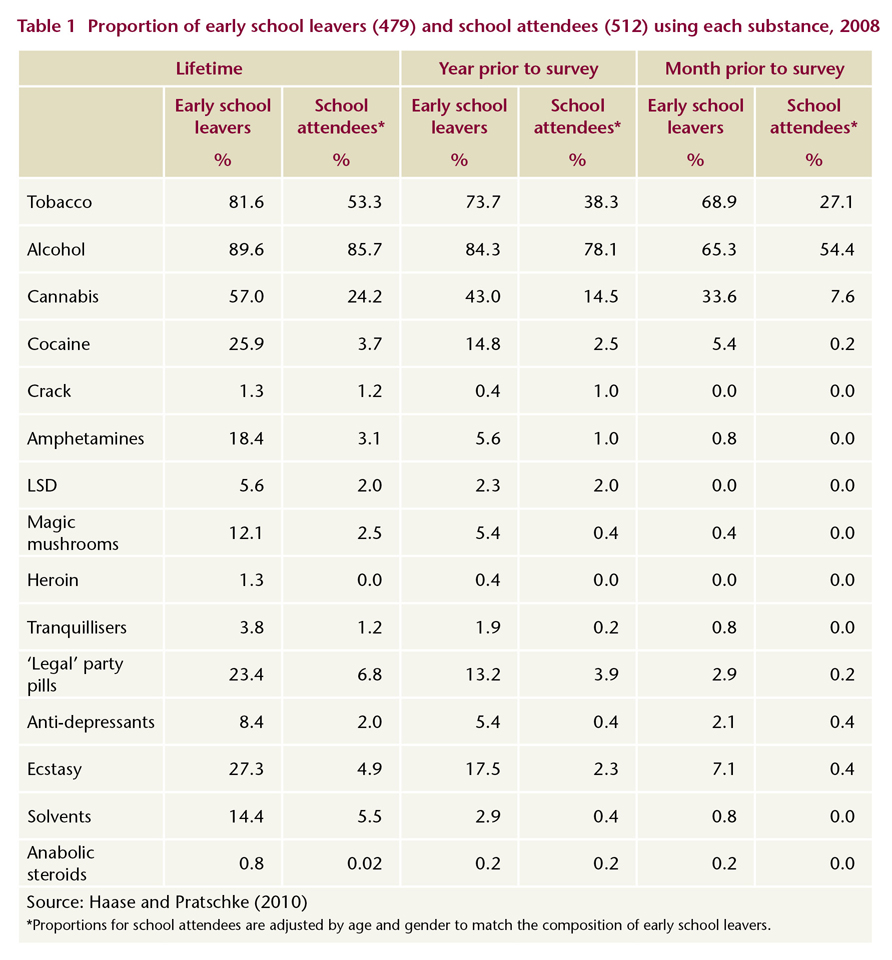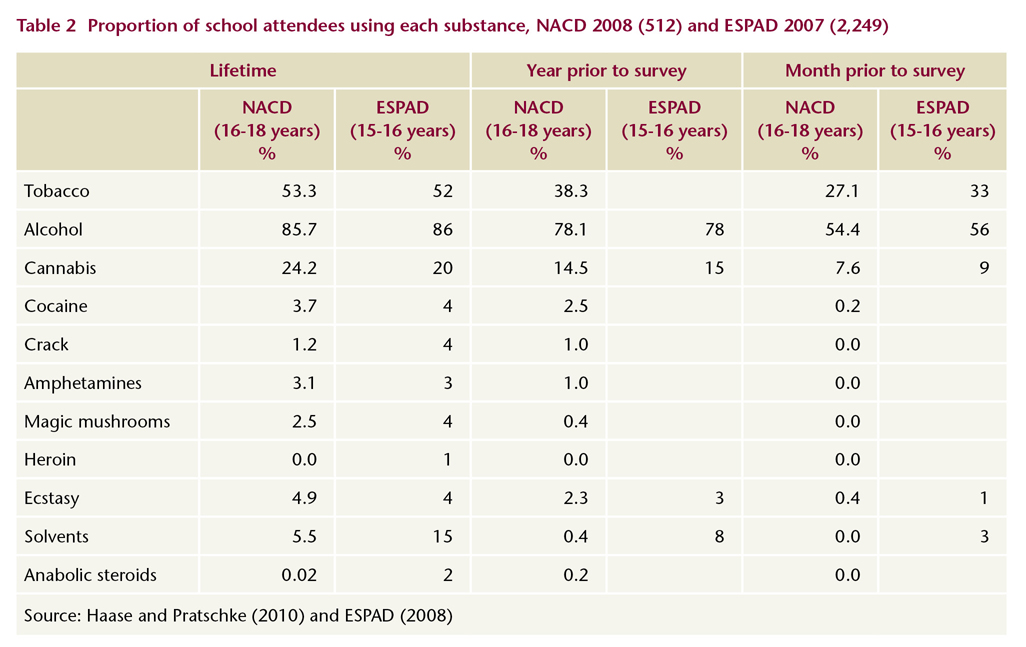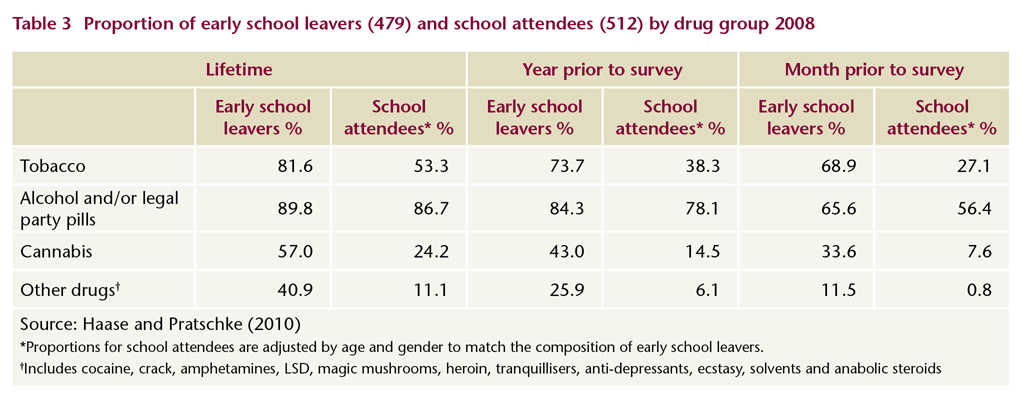Long, Jean and Keane, Martin
(2011)
NACD study on risk and protective factors for substance use among young people.
Drugnet Ireland,
Issue 36, Winter 2010,
pp. 16-18.
A study commissioned by the National Advisory Committee on Drugs (NACD) reported findings in relation to drug use among 479 early school leavers and 512 school attendees aged 16–18 years, and identified risk and protective factors for substance use.1 Data were collected throughout Ireland in March–May and September–December 2008. The participants were interviewed face-to-face. A second questionnaire on the attributes of the schools or education centres was completed by the school principal or education/training centre manager.
The drugs used and the proportions using each drug are presented in Table 1. It is clear that use of substances other than alcohol was more common among early school leavers than among school attendees. Table 2 presents the prevalence of drug use among the school attendees in this NACD study compared to that reported by participants in the 2007European School Survey Project on Alcohol and Other Drugs (ESPAD) survey. With the exception of crack cocaine and solvents, the proportions reporting use of each drug were similar in both studies.


In order to examine the relationship between drug use and other attributes or factors, the types of drugs used were classified into four groups: 1) tobacco or cigarettes, 2) alcohol and legal party pills, 3) cannabis, and 4) other drugs (Table 3). Use of the four groups of drugs was examined across three time periods: lifetime use, use in the 12 months prior to the survey, and use in the 30 days prior to the survey.

Seventy attributes or factors which described the young people studied were identified and grouped into five categories: 1) personal characteristics and attitudes, 2) factors related to parents and home, 3) factors related to the education centre or school, 4) substance use within the peer group, and 5) characteristics of the neighbourhood in which the young person lived. The relationships between drug use and other factors were analysed using multi-level models. The main relationships are highlighted below.
Factors related to the young person
Age had a minor influence on drug use. Alcohol consumption increased with age among students attending school, particularly among those aged over 18 years. Gender had no influence on alcohol, tobacco or other drug use. Ethnicity influenced alcohol consumption and cannabis use among early school leavers. Travellers and non-white ethnic minorities were less likely to use alcohol and cannabis than white Irish early school leavers. Ethnicity had no influence on alcohol, tobacco, cannabis or other drug use among students attending school.
Low self-concept or self-esteem increased the likelihood of smoking cigarettes among both groups. Aggressive ‘acting-out’ behaviour was associated with use of alcohol among both groups.
Having a girl or boy friend increased the likelihood of smoking cigarettes among both groups, and of cannabis use among early school leavers.
There were strong interactions between the use of one substance and the use of another. Among both early school leavers and students attending school, having tried cigarettes was a strong predictor of drinking alcohol and using cannabis. Having drunk alcohol at least once predicted having smoked cigarettes. For both groups, having used cannabis increased the likelihood of using other drugs, and for students attending school, having dabbled in drugs increased the odds of using cannabis.
Factors related to the young person’s parents and home
Parental involvement and concern were protective factors, although they appeared to affect different substance classes in each of the two groups. For school attendees, parental concern reduced the likelihood of drinking alcohol. For early school leavers, parental concern reduced the likelihood of drinking alcohol and using cannabis. Parental involvement and concern did not influence whether or not those in either group smoked.
Substance use by parents or siblings increased the risk of a young person using the same substance. If parents or siblings drank alcohol, smoked cigarettes used cannabis or used other drugs, there was an increased likelihood that the school attendee did likewise. If the parents of early school leavers smoked cigarettes or used cannabis, the odds were increased that the young person did likewise.
Factors related to the training centre or school
Factors relating to the centre or school were measured at the individual level and at the level of the educational establishment. The latter data were collected through a separate questionnaire completed by the person in charge of the training centre or school.
A positive relationship with supportive teachers or a positive school experience had a beneficial effect on school attendees in terms of reducing the risk of drinking alcohol and of using cannabis or other drugs. However, it had no effect on the likelihood of smoking cigarettes. These positive effects were not detected among the early school leavers. The authors state (p. 14):
Two considerations follow from this observation. First, the relationship between these aspects of the school experience, on the one hand, and substance use, on the other, is likely to involve reciprocal effects. Students who have a satisfying and enjoyable school experience are less likely to use substances, and those who do not use substances are more likely to have a good relationship with teachers and school. Secondly, this effect is remarkable by its absence among early school-leavers, suggesting that those who have left school early are relatively homogeneous in relation to this characteristic. These are, as other studies have shown, young people who have not had a positive experience of school or good relationships with teachers in general This underlines the close, internal relationship that exists between early school-leaving and substance use, which forms the backdrop to this study.
Small effects were identified in relation to the educational establishment: the provision of drug awareness and information sessions for staff working in training centres reduced the likelihood that early school leavers used cannabis or other drugs. The unmet counselling needs of early school leavers who attended training centres were associated with higher alcohol consumption. Within the school sector, the number of substance use classes or information sessions for parents was associated with a lower risk of cigarette smoking among students attending school, and small positive effects were observed for schools with substance use policies.
Factors linked to the young person’s peer group
Substance use by the peer group was a risk factor rather than a protective factor for both groups. Positive peer group activities, such as playing sport, were not examined. If most of the interviewee’s friends smoked cigarettes, drank alcohol, or used cannabis or other drugs, there was a greater likelihood that he or she did likewise. The authors state ‘it is equally possible that young people choose their friends, at least in part, on the basis of prior substance-use behaviour or factors that are causally related to this’.
Rates of cigarette smoking were not affected by ease of access in the case of either group. Ease of access to alcohol did not influence consumption among early school leavers; interestingly, however, it did increase the likelihood of consumption among those still attending school. Among both groups, rates of cannabis and other drug use were significantly higher where access to the specific drug was easier.
Factors related to the neighbourhood
The influence of factors related to the neighbourhood was comparatively small. The neighbourhood relationships identified were not easy to explain and may mask other unanswered questions.
Conclusion
This study identifies a number of risk and protective factors which can increase or decrease the risk of using substances among 15–18-year-olds in Ireland. The authors conclude: ‘When attention is focused on those factors that are amenable to change, the most important conclusion is that both the family (the young person’s parents above all) and the educational institution can have a major impact on this decision’ (p. 16). In addition, we need to examine how we provide interventions targeted to the individual and his/her peer group. The article on p.19 below comments on the risk and protective factors identified in the NACD study and in other research literature, and may facilitate the development of such interventions.
1. Haase T and Pratschke J (2010)
Risk and protection factors for substance use among young people: a comparative study of early school-leavers and school-attending students. Dublin: Stationery Office. Available at
www.drugsandalcohol.ie/14100

